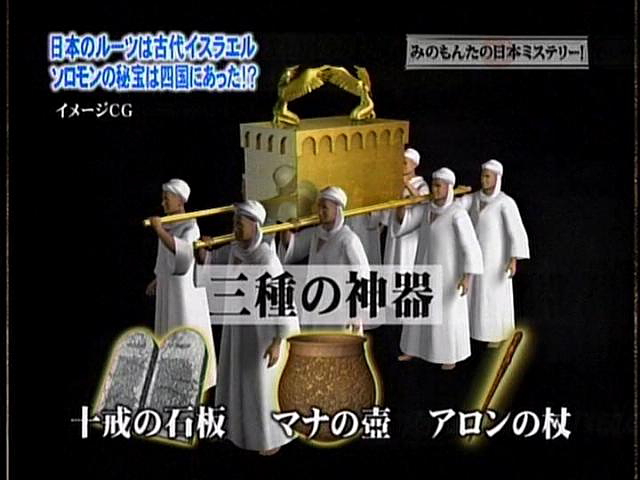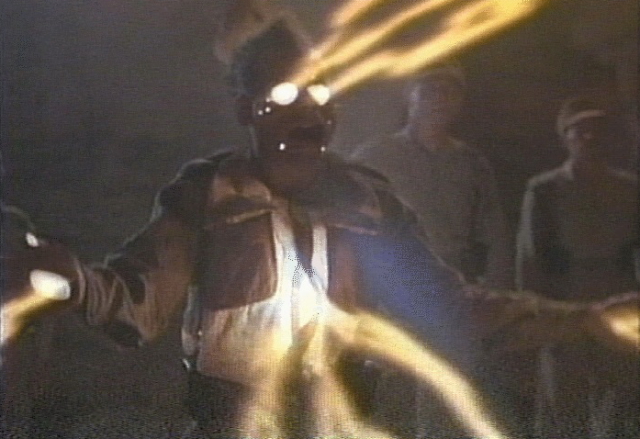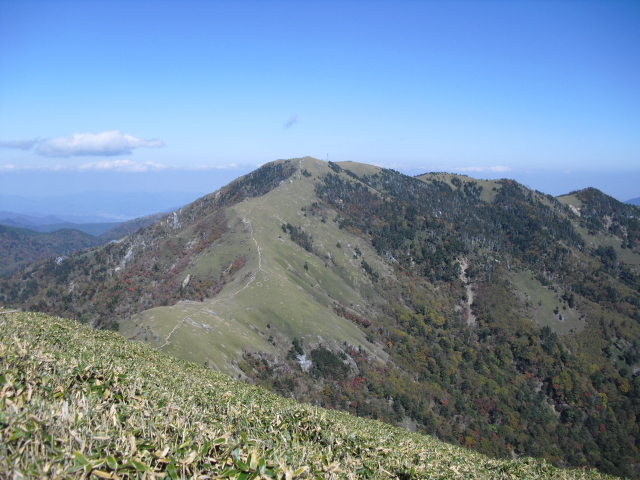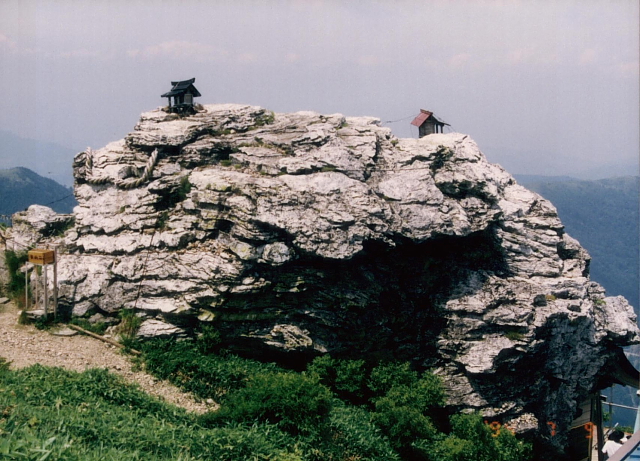The fabled lost Ark of the Covenant -- described in the Bible as the sacred container of the Ten Commandments -- lies buried near the top of Mt. Tsurugi on the Japanese island of Shikoku, according to local legend.

The Ark, which was built according to instructions given by God to Moses in a prophetic vision on Mt. Sinai, is sacred to Jews and Christians alike and is said to possess great supernatural powers.
Many people also know it from the 1981 action film "Indiana Jones and the Raiders of the Lost Ark," which follows the adventures of archeologist Indiana Jones as he thwarts Nazi efforts to obtain the Ark and harness its powers for evil.

Scene from "Raiders of the Lost Ark"
But what really happened to the Ark? According to the biblical book of Kings, King Solomon -- a King of Israel -- built a large temple in Jerusalem to house the sacred object, and it was kept there during his reign (970-930 BC) and beyond. Centuries later, in 586 BC, the Babylonians conquered Jerusalem and destroyed the temple. Some historians suggest the Ark was probably carted off by the Babylonians or perhaps destroyed in battle, but nobody knows for sure. Its fate remains one of the world's great unsolved mysteries.
Since its disappearance, various groups around the world claim to have discovered or obtained possession of the Ark. The list of locations includes Jordan, Egypt, Ethiopia, southern Africa, France, UK, Ireland -- and Japan.

Did a lost tribe of Israel carry the fabled Ark to Mt. Tsurugi?
In Japan, the rumored site of the legendary lost Ark is at Mt. Tsurugi in Tokushima prefecture. At 1,955 meters (6,413 ft), the mountain -- known locally as "Ken-zan" -- is the highest on Shikoku and the second highest in western Japan. Mt. Tsurugi is listed as one of Japan's 100 famous mountains and is considered the most sacred peak on Shikoku. It is also regarded as one of the centers of Shugendo, an ancient ascetic religion that incorporates elements of Shintoism and Buddhism.

Tsurugi Jinja, a tiny shrine atop Mt. Tsurugi
Speculation surrounding the lost Ark at Mt. Tsurugi can be traced back to the work of Masanori Takane (1883-1959), a literary scholar with a deep interest in kotodama (lit. "word spirit") -- a Japanese belief that words and names hold mystical powers. Through his kotodama research, which involved the study of ancient history, philosophy, theology and cosmology, Takane came across a number of uncanny parallels between the Bible and the Kojiki ("Record of Ancient Matters"), an 8th-century collection of myths concerning the origin of the Japanese islands and Shinto kami (spirits).
In addition to suggesting possible links between the Bible and the origins of Shinto, Takane's research points to the Japanese island of Shikoku as the crucial bridge between the two. The Book of Revelation (7:1), for example, describes John's vision of "four angels standing at the four corners of the earth." Takane interpreted this as a reference to Shikoku (whose name literally means "four countries"), which is described in the Kojiki as having "four faces." After an exhaustive study of Shikoku's geography, climate, local names and folklore, Takane concluded that the lost Ark of the Covenant was buried near the peak of Mt. Tsurugi.
Here is a look inside a cave at Mt. Tsurugi, which may or may not be connected to a larger underground structure containing the lost Ark of the Covenant.
+ Video
In 1936, Takane assembled a team of archeologists and began an excavation at Mt. Tsurugi. Over the next three years, they dug up an area measuring about 150 meters (500 ft) long and found stone artifacts, paving stones, a brick arch, and evidence of tunnels. The discoveries helped lend credibility to Takane's theory that ancient people modified the peak of Mt. Tsurugi in order to hide the treasure.
Takane and others conducted excavations on Mt. Tsurugi for the next 20 years. In 1952, a former naval admiral named Eisuke Yamamoto attracted national attention when his excavation team found what appeared to be badly decomposed mummies and evidence of marble corridors. Soon after the discovery, however, both Takane and Yamamoto mysteriously stopped searching for the lost Ark at Mt. Tsurugi.
Another treasure hunter named Yoshun Miyanaka began an excavation in 1956, but the effort was short-lived. In 1964, the Japanese government established the Tsurugi-san Quasi-National Park, a 210-square-kilometer (81 sq mi) nature preserve encompassing Mt. Tsurugi and the surrounding area. Excavations on the mountain were banned for environmental reasons.
The lost Ark of the Covenant was never found at Mt. Tsurugi, but the legend lives on.
[Note: This is the latest in a series of weekly posts on mysteries and urban legends from Japan.]

Pastor Ezekiel
This is pure blasphemy!
[]Word
Praise "Bob!"
[]Pope V the Victorious
Even purer blasphemy! Hail Eris!! All Hail Discordia!!!
[]chris
I don't think it's any more blasphemy than hijacking and misinterpreting Jewish holy scripture, only to refer to it comparably as an "old" testament.
[]richard head
r u japanese? i thought the ark was at the LuacasFilm studios!tell u about all the possibnilities!
[]William
This is really cool and I would've been disappointed if you hadn't included a picture from Indiana Jones. :)
The Ark (probably?) isn't on Mt Tsurugi, but it sure sounds like something interesting is...
[]Nathaniel
Might possibly be King Solomon's treasure. which is said to be inside Mt. Tsurugi, and be guarded by a giant snake. a lot of questions are brought up when Mt. Tsurugi is mentioned. some people believe that it isn't a mountain at all, that it is actually a man made pyramid where king Solomon stored a portion of his treasure. but we will never know I guess.
[]Ginko
The logic used by Takane really seems twisted.
[]Well, it seems that he found something nonetheless...
Tonk
Not so much blasphemy, at all, actually, people! Read this:
http://www.moshiach.com/features/tribes/japan.php
[]Brandon
Interesting insignt into Japanese culture, you usually do not associate roots of christianity with the island.
[]Renk
I don't know if I'd believe the ark is there, but something certainly is. A 20+ year dig doesn't normally just end like that after finding such artifacts and adding fuel to the fire is the Government suddenly including the area in the nature preserve, conveniently banning further excavations. Interesting stuff.
[]Kerwin
I think this guy knows a lot about the subject, you should track him down.
http://raretreats.livejournal.com/tag/nazis
[]Dan
well but it never mention anything scientific nor anyithing is made of wood and not even xraying(sona dectection?) the entire cave to see if there is any remains etc just not enough evidence..... + just judge by the sound and translation of the place's name is not the way to determin where it is....
[]D
Very interesting story, indeed! It would totally shock the world if the ark is really in Japan, though many other claims are just like this one.
on a side note, I thought that the words "Japanese are Jewish" were misleading, though it only refer to the video clips. Upon watching the video, I understood it was only meant that Japanese are influenced by Jewish rituals and custom and incorporate them into Japanese culture. Not strange since Japanese were very open to the ideals and culture of the mainlands...
anyway, now I wonder, if the ark were really in Japan, what would happen to it? Would it be sent to Israel or kept in Japan. No doubt, it's very important to Jewish and probably Christians around the world and Israel would definitely want it back in their homeland, but since the Jewish tribe did brought it to Japan over 1000 years ago and the people became incorporated into Japanese society, don't Japan have to it as well?
[]Would Japan keep it and designate it as a national treasure or forced to return it to Israel? Its no doubt a priceless treasure and have extremely religious and cultural value, and I'm not saying that the two nation can't share it, coming up with a plan to benefit both nation or that Japan may just give it away... What I want to know is who would have the right to the Ark of the Covenant?
of course, this is all irrelevant until they can prove it's there, but I'm just really curious. I always comes up with some really strange question, a curious person...
stryph
And THAT, my friend, is why it suddenly became a "national park"...because if no one knows it's there, they can't take it away.
I kid, and it does seem rather like the guy who started this whole thing took two convenient endpoints and manufactured the "facts" to connect them as needed.
[]Liz
Not surprised, but needs to be taken back further. Jewish people were Egyptian or at least part Egyptian. the language and culture mingled a lot back then.
Yoruba, a Nigerian language, has a cadence very similar to Japanese. Vowel rich, melodic sounding (I'm always asked if my last name is Hawaiian). Yoruba are said to be descended from ancient Egyptians.
So there's more of a chance that while Japanese may not be as sensationally Jewish as the video reads, there could have been Egyptians/Jewish people who reached the island and settled their. Read up on Egyptian/Jewish diasporae!
[]Johnchapman
I enjoyed the post, it's really good, very useful :D Thank you.
[]Chris
Tsurugi-san is the 2nd highest mountain on Shikoku. Ishizuchi-san is the highest.
[]